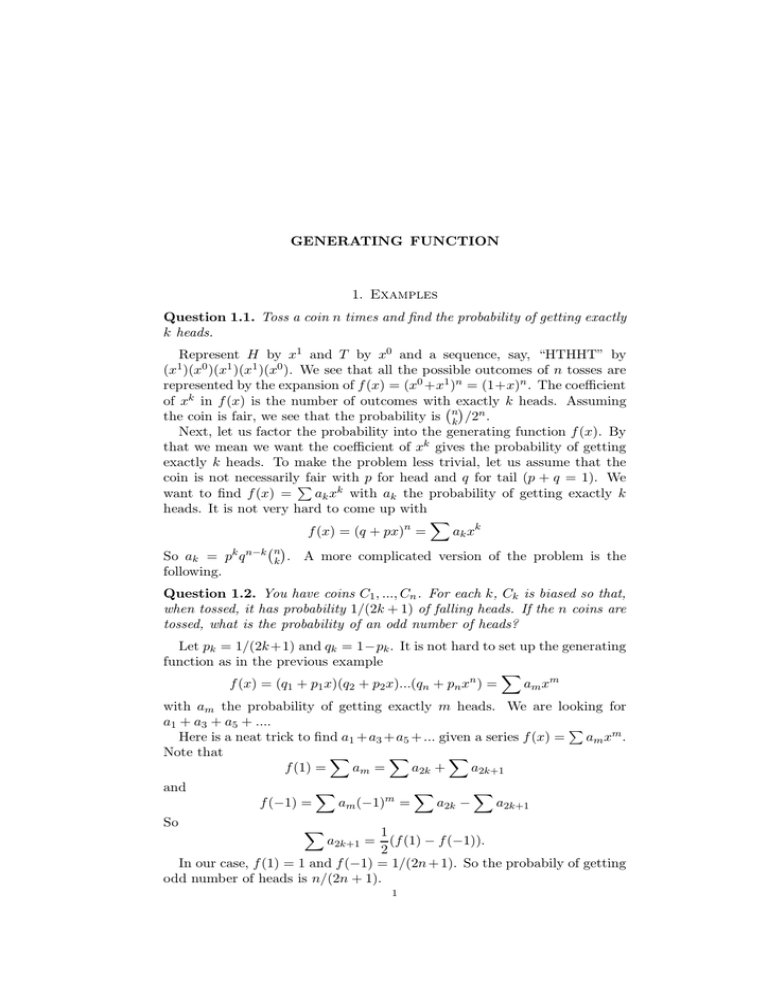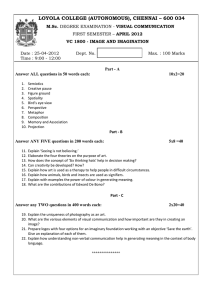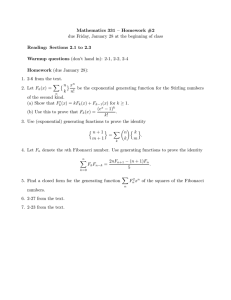GENERATING FUNCTION 1. Examples Question 1.1. Toss a coin n
advertisement

GENERATING FUNCTION
1. Examples
Question 1.1. Toss a coin n times and find the probability of getting exactly
k heads.
Represent H by x1 and T by x0 and a sequence, say, “HTHHT” by
We see that all the possible outcomes of n tosses are
represented by the expansion of f (x) = (x0 +x1 )n = (1+x)n . The coefficient
of xk in f (x) is the number of outcomes with exactly
n k heads. Assuming
n
the coin is fair, we see that the probability is k /2 .
Next, let us factor the probability into the generating function f (x). By
that we mean we want the coefficient of xk gives the probability of getting
exactly k heads. To make the problem less trivial, let us assume that the
coin is not necessarilyP
fair with p for head and q for tail (p + q = 1). We
want to find f (x) =
ak xk with ak the probability of getting exactly k
heads. It is not very hard to come up with
X
f (x) = (q + px)n =
ak xk
So ak = pk q n−k nk . A more complicated version of the problem is the
following.
(x1 )(x0 )(x1 )(x1 )(x0 ).
Question 1.2. You have coins C1 , ..., Cn . For each k, Ck is biased so that,
when tossed, it has probability 1/(2k + 1) of falling heads. If the n coins are
tossed, what is the probability of an odd number of heads?
Let pk = 1/(2k+1) and qk = 1−pk . It is not hard to set up the generating
function as in the previous example
X
f (x) = (q1 + p1 x)(q2 + p2 x)...(qn + pn xn ) =
am xm
with am the probability of getting exactly m heads. We are looking for
a1 + a3 + a5 + ....
P
Here is a neat trick to find a1 + a3 + a5 + ... given a series f (x) = am xm .
Note that
X
X
X
f (1) =
am =
a2k +
a2k+1
and
f (−1) =
So
X
am (−1)m =
X
a2k −
X
a2k+1
1
a2k+1 = (f (1) − f (−1)).
2
In our case, f (1) = 1 and f (−1) = 1/(2n + 1). So the probabily of getting
odd number of heads is n/(2n + 1).
X
1
2
GENERATING FUNCTION
P
• P
Given f (x) = am xm . What if we want to find a0 +a3 +a6 +... =
a3k ?
P
• More generally, What if we want to find
apk+r for some fixed p
and r. Hint: use roots of unity.
P
Question 1.3. Find the number of ways of changing a 500 dollar bill into
$1, $2, $5, $10, $20’s.
Let k1 , k2 , k3 , k4 , k5 be the number of $1, $2, $5, $10, $20’s, respectively.
We are looking at the numbers of nonnegative integral solutions of the equation:
k1 + 2k2 + 5k3 + 10k4 + 20k5 = 500.
Set up the correspondence
(k1 , k2 , k3 , k4 , k5 ) → (xk1 )(x2k2 )(x5k3 )(x10k4 )(x20k5 )
Then the number of the solutions of the equation is the coefficient of x500 in
∞
∞
∞
∞
∞
Y
Y
Y
Y
Y
f (x) =
xk 1
x2k2
x5k3
x10k4
x20k5
k1 =0
k2 =0
2
k3 =0
2
k4 =0
4
5
= (1 + x + x + ...)(1 + x + x + ...)(1 + x + x
k5 =0
10
+ ...)
(1 + x10 + x20 + ...)(1 + x20 + x40 + ...)
1
=
(1 − x)(1 − x2 )(1 − x5 )(1 − x10 )(1 − x20 )
Of course, to find the Taylor expansion of f (x), we have to write f (x)
as a sum of partial fractions, which is doable in theory but impossible by
hand.
But we can still say a lot about the coefficients of f (x). Let f (x) =
P
p(n)xn , i.e., p(n) is the number of the ways changing n dollar. Then the
following is true:
• p(n) grows at the order of n4 as n → ∞. I leave this as an exercise.
• p(20n) is a polynomial in n of degree 4. This is a little bit harder to
prove.
•
4
X
Y n−l
p(20n) =
p(20k)
k−l
0≤l≤4
k=0
l6=k
This uses interpolation formula. Once we know that p(20n) is a
polynomial of degree 4 and the values of p(20n) at five points, say
p(0), p(20), p(40), p(60), p(80), we can find p(20n) by interpolation.
More generally, the number of nonnegative integral solutions
(x1 , x2 , ..., xm ) of the equation
λ1 x1 + λ2 x2 + ... + λm xm = n
GENERATING FUNCTION
3
is given by the coefficients of the generating function
1
.
f (x) =
λ
(1 − x 1 )(1 − xλ2 )...(1 − xλm )
• What if we are looking for integral solutions xi within the range,
say αi ≤ xi ≤ βi ? What is the corresponding generating function?
• What if we are looking for odd solutions, solutions with xi ≡
1(mod 3) and etc? What are the corresponding generating functions?
Question 1.4. Let n be a positive integer. Find the number of
polynomials P (x) with coefficients in {0, 1, 2, 3} such that P (2) = n?
Let P (x) = a0 + a1 x + a2 x2 + ... + ak xk + .... We are looking at
the solutions of
a0 + 2a1 + 4a2 + ... + 2k ak + ... = n
with 0 ≤ ak ≤ 3. The number of such solutions are given by the
coefficient of xn in
f (x) = (1 + x + x2 + x3 )(1 + x2 + x4 + x6 )(1 + x4 + x8 + x12 )...
=
∞
Y
k
k
k
(1 + x2 + x2(2 ) + x3(2 ) )
k=0
∞
Y
k+2
1
1 − x2
=
=
k
2
(1 − x)(1 − x2 )
1−x
k=0
1
1
1
1
1
1
=
+
+
4 1−x
2 (1 − x)2
4 1+x
∞ X
1 1
1
n
=
+ (−1) + (n + 1) xn
4 4
2
n=0
Another way to express the result is ⌊n/2⌋ + 1.
• Find a purely combinatorial solution to the problem.
Question 1.5. Find the number of subsets of {1, ..., 2003}, the sum
of whose elements is divisible by 5.
Set up the correspondence:
S = {s1 , s2 , ..., sk } → σ(S) = xs1 xs2 ...xsk .
Then
X
σ(S) = f (x) = (1 + x)(1 + x2 )...(1 + x2003 )
S⊂{1,...,2003}
The coefficient of xn in f (x) is the number of subsets of {1, P
..., 2003},
the number of whose elements is exactly n. So if f (x) =
an xn ,
4
GENERATING FUNCTION
we are looking for the sum a0 + a5 + a10 + .... Let rn = exp(2nπi/5)
be the 5-th roots of unity. Then
1
a0 + a5 + a10 + ... = (f (r0 ) + f (r1 ) + f (r2 ) + f (r3 ) + f (r4 )).
5
Obviously, f (r0 ) = 22003 . For 1 ≤ k ≤ 4,
400
f (rk ) = (1 + rk0 )(1 + rk1 )(1 + rk2 )(1 + rk3 )(1 + rk4 )
(1 + rk1 )(1 + rk2 )(1 + rk3 )
= 2400 (2 + 2rk + rk2 + 2rk3 + rk4 )
and hence
4
X
f (rk ) = 2400 (8 − 2 − 1 − 2 − 1) = 2401 .
k=1
So the answer is (1/5)(22003 + 2401 ).
• Replace 2003 by n = 5k + l and redo the computation.
• Find a purely combinatorial solution to the problem.
Question 1.6. Suppose that each of n people writes down the numbers 1, 2, 3 in random order in one column of a 3 × n matrix, with
all orders being equally likely and independent. Show that for some
n ≥ 1995, the event that the row sums are consecutive integers is at
least four times likely as the event that the row sums are equal.
Instead of (1, 2, 3), we use (−1, 0, 1). Set up the correspondence:
a
b → xa y b
c
Then a 3 × n such matrix can be represented by a term in the expansion of
1 1 n
x y
φn (x, y) = x + y + + + +
y
x x y
Let an be the constant term in φn (x, y). It is not hard to see that
an is exactly the number of matrices with equal row sums. Let
bn , cn , dn , en , fn , gn be the coefficients of x, y, x/y, y/x, 1/x, 1/y in
φn (x, y). It is not hard to see that bn + cn + dn + en + fn + gn
are the number of matrices with consecutive row sums. Actually,
from
1 1
x y
φn (x, y)
φn+1 (x, y) = x + y + + + +
y
x x y
we see that
an+1 = bn + cn + dn + en + fn + gn
GENERATING FUNCTION
5
We are essentially asked to show
Pthatn an /an+1 ≤ 1/4 for n large.
In other word, if we put ϕ(t) =
an t , it suffices to show that the
radius of convergence of ϕ(t) is less than 1/4. This suggests us to
put all φn (x, y) together into
X
H(x, y, t) =
φn (x, y)tn
If we expand H(x, y, t) as an infinite series in (x, y) (one technical issue here: H(x, y, t) expands as a Laurent series), ϕ(t) is the constant
term.
The rest of the proof is quite technical. You need to know some
complex analysis to understand it. I will list the key steps.
First, compute H(x, y, t):
xy
H(x, y, t) =
xy − t(x2 y + xy 2 + x2 + y 2 + x + y)
xy
=
2
−t(y + y ) + (y − ty 2 − t)x − (ty + t)x2
Second, expand H(x, y, t) in x gives us that ϕ(t) is the constant
term in the Laurent series of
y
p
2
(y − ty − t)2 − 4t2 (y + 1)2 y
Then
Z
1
y
p
ϕ(t) =
dy
2πi C (y − ty 2 − t)2 − 4t2 (y + 1)2 y
where C = {|y| = 1} is the unit circle.
Finally, it takes some effort to show that ϕ(t) is a meromorphic
function in t and it has singularities when ∆(y) = (y − ty 2 − t)2 −
4t2 (y + 1)2 y has a double root on the unit circle. This gives us
singularities of ϕ(t) at t = 1/6 and t = −1/2. So the radius of
convergence of ϕ(t) is at most 1/6.
2. Exercise
Question 2.1. Let p(n) be the number of ways of changing n dollars
into coins and bills of $1, $2, $5, $10, $20’s. Show that
1
p(n)
=
.
lim
4
n→∞ n
2 · 5 · 10 · 20
Question 2.2. Throw a dice n times and find the probability of
getting a sum which is divisible by 5.





